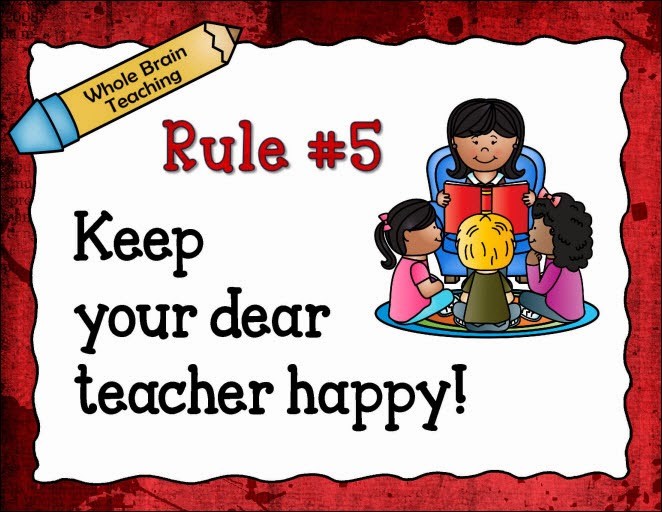Guest post by Chris Biffle
Director, Whole Brain Teaching
Note: The rule Chris described in this post has changed since this article was written. Rule #5 now reads, “Make our dear team stronger.” Because this article is part of a series of guest blog posts, I chose to leave it in place despite the change in Rule 5. Many of the tips and strategies mentioned in this article are still relevant.
This is the final post in the WBT’s Classroom Transforming Rules series. To find all of the posts in the series, click here. To see Whole Brain Teaching in action, watch the videos on the WBT website.
Need a rule that stops back-talking students in their tracks? Discover the golden signpost on the road to Teaching Heaven.
When my teaching colleagues and I developed Whole Brain Teaching’s classroom rules in 1999, our goal was to cover every classroom problem.
We wanted a couple of rules that were as specific as possible and one or two others that covered all varieties disruptive behavior. Thus, we have three rules that target specific classroom problems. As described in this series,
- Rule 1: “Follow directions quickly” addresses slow transitions.
- Rule 2: “Raise your hand for permission to speak,” targets kids who are spontaneously chatty.
- Rule 3: “Raise your hand for permission to leave your seat,” keeps classrooms from turning into playgrounds.
Unfortunately, these three rules don’t cover every classroom misbehavior. Rule 4 “Make smart choices” is marvelously general, addressing every decision a child (or adult!) can make. Rule 4 can be applied to any issue not covered by the first three rules.
So, why do we need Rule 5, “Keep your dear teacher happy?” Rule 5 addresses your most challenging students … the ones who will quarrel with you about Rules 1-4! (Click here to download all the free rule posters.)
- Children who dawdle along, can claim they are following directions quickly.
- Chatty students can claim they weren’t speaking to anyone.
- Your most challenging kids can even deny they are out of their seat … when they are standing in the middle of the classroom! “I’m not out of my seat. I’m just getting my pencil sharpened.”
Of course, your most resistant spirits can argue that all their choices are smart, no matter how obviously foolish.
So, what’s a beleaguered teacher to do? You need one rule that can’t be disputed. In 15 years in thousands of classrooms, we’ve never had a child convince their instructor that their disruptive behavior made the teacher happy! Rule 5 is the argument stopper, the backtalk squelcher, the golden signpost to Teaching Heaven.
If a parent or administrator is troubled by the rule, explain, “I know Rule 5, ‘Keep your dear teacher happy’ sounds like it is about me, but that’s not the case. My only happiness is seeing my students learn.”
Here’s a two-step procedure to establish Rule 5, “Keep your dear teacher happy.”
Step One
For a minute or so, five times a day, rehearse the five classroom rules. You call out the rule number; your students rapidly reply with the rule and the matching gesture. After several weeks, place special emphasis on Rule 5. During rehearsals and at random times during the day, call out “Rule 5!” Students respond, “Keep your dear teacher happy!” while framing their smiling faces with their fingers.
As an explanation of the rule, say something like the following to your kids, “It doesn’t take presents, or anything material, to keep me happy. I only want one thing, one thing in all the universe, and that’s seeing you learn. Your growth as students fills my heart with happiness.”
Step Two
Once students can instantly respond with the rule and gesture, when you call out “Rule 5,” you’re ready for implementation.
Pick a lively student, Sarah, and say, “I’m going to pretend like I’m teaching and then I’ll say to you, Sarah please pay attention. I want you to say back, with real attitude in your tone of voice “I am paying attention!”
This will be wonderfully shocking to your class … a student gets to backtalk you! And so, the little skit is played. When Sarah backtalks, you exclaim, “Great job Sarah! That was a wonderful example of breaking Rule 5! Class, give her a 10 finger woo!!” Your kids extend their wiggling fingers toward Sarah and exclaim, “Woo!” (More fun than applause.)
Then say, “This time when Sarah backtalks, I’ll call out Rule 5. I want you to respond using our gesture and quickly say, ‘Keep your dear teacher happy!”
Follow this routine once or twice until the class instantly implements the Rule 5 callback.
For several days, and whenever necessary thereafter, practice the routine just described. We’ve found that the key to stopping challenging behavior is to practice the class response … before disruption occurs!
The only problem we’ve discovered with implementing Rule 5 is that students implement it too eagerly! Kids will start calling out “Rule 5!” whenever they hear the slightest amount of guff. When this occurs say, with a broad, honest grin, “I appreciate how quickly you are using Rule 5 … but believe me, I will let you know when I think it’s necessary.” Oh happy day … your kids have your back at the faintest whisper of ornery behavior!!!
If you don’t have challenging kids, then Rules 1-4 will be all you’ll need. Of course, if your classroom has no disruptions, then you’re already in Teaching Heaven!
To download the free classroom rule posters described in this article, click here or on the Rule 4 poster image above.
For more information on Rule 5 and WBT’s other classroom rules, look at Chapter 7 in “Whole Brain Teaching for Challenging Kids” on Amazon.com.
Director, Whole Brain Teachers of America
Website: WholeBrainTeaching.com
Facebook | Twitter | Youtube | WBT Bookclub | Webcast ArchiveChris Biffle, a college philosophy professor for 40 years, is the author of seven books (McGraw-Hill, HarperCollins) on critical thinking, reading and writing. He has received grants from the U.S. Department of Education and the National Endowment for the Humanities. In the last 15 years, Chris has been lead presenter at over 100 Whole Brain Teaching conferences, attended by 20,000+ educators. Thousands of instructors across the United States and around the world base their teaching methods on his free ebooks available at WholeBrainTeaching.com.









